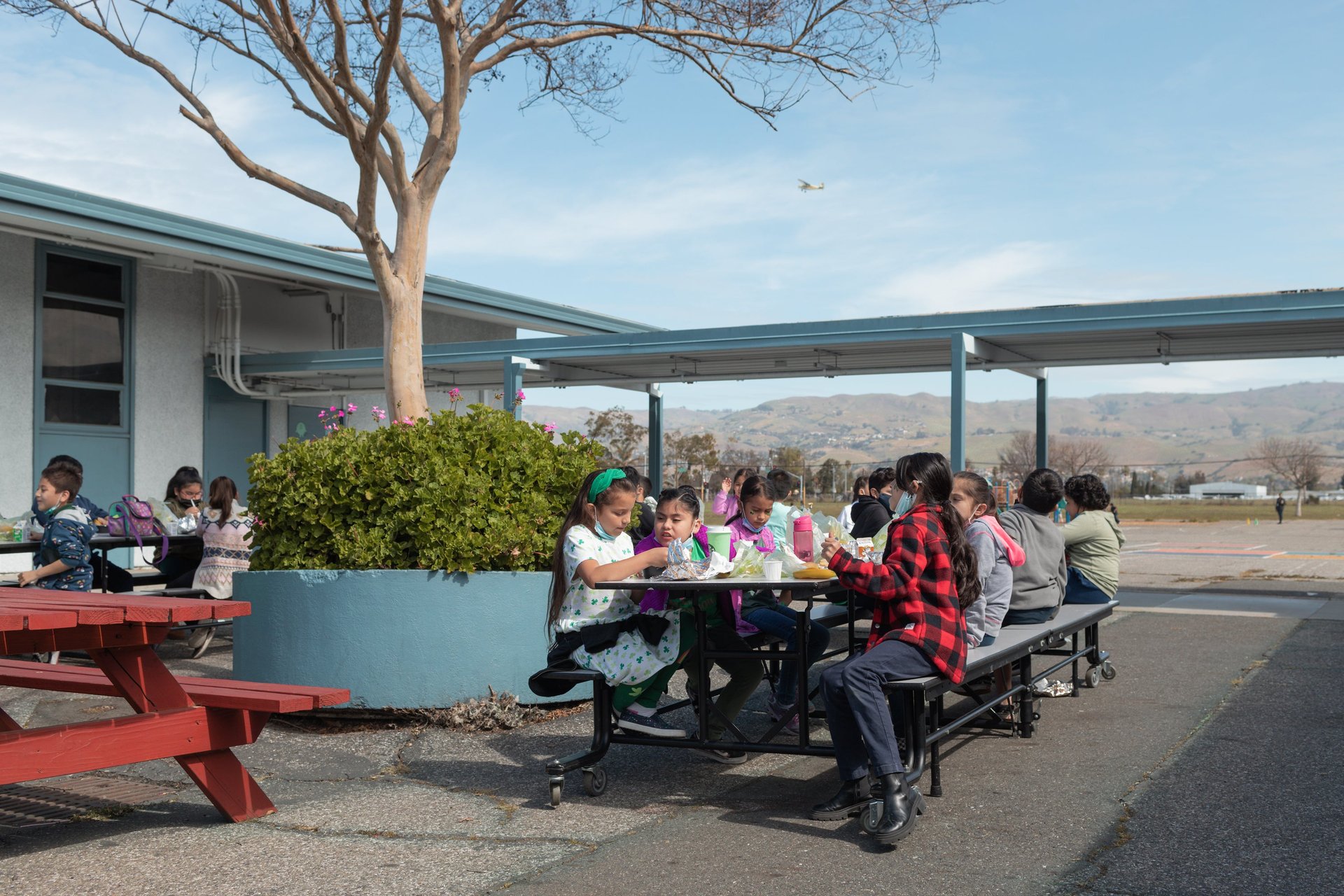Living with the risk of childhood lead exposure: A day in the life
Each weekday, Michelle Lopez readies breakfast—scrambled eggs and a mug of hot chocolate on this chilly March morning—for her daughter, seven-year-old Holland Nicole Moreno. As she brushes Holland’s waist-length brown hair, the two chat and laugh about the day ahead. “My daughter is like my best friend,” says Lopez. “We have, like, that Gilmore Girls relationship. I absolutely love it.”


Each weekday, Michelle Lopez readies breakfast—scrambled eggs and a mug of hot chocolate on this chilly March morning—for her daughter, seven-year-old Holland Nicole Moreno. As she brushes Holland’s waist-length brown hair, the two chat and laugh about the day ahead. “My daughter is like my best friend,” says Lopez. “We have, like, that Gilmore Girls relationship. I absolutely love it.”
Soon they are off in the car for the short drive to Donald J. Meyer Elementary School. Holland is the third generation in her family to attend school there. “My little brother went there,” says Lopez, who like her daughter was raised here in San Jose, California. “My older brother went there. My dad.”

As Holland exits the car, airplanes at Reid-Hillview Airport, which shares a fence line with Meyer Elementary, already are lifting off.
Reid-Hillview, in the heart of Silicon Valley, is one of the busiest civil aviation airports in the country. Every year, more than 200,000 takeoffs and landings, many from the four flight schools in the area, occur here.
For decades, every one of those airplanes was refueled with toxic leaded aviation gasoline, the last major fuel in the US to contain lead as a way to boost octane levels.

While virtually ignored in the US until recently, the country’s approximately 3,000 aviation airports are now the largest source of airborne lead in the US, pumping 468 tons into the air every year. Much of it settles on communities within one kilometer of these airports—a radius that’s collectively home to 16 million people around the country, including 3 million children.
More than half a century after the US began phasing out lead from gasoline used in automobiles, studies on the health effects of lead show how the US is needlessly poisoning another generation of children.
Learning about the risks of leaded fuel
Holland’s family arrived in San Jose in the 1960s, drawn by good jobs and affordable homes amid the factories and semiconductor firms comprising what would soon be known as Silicon Valley. Today, roughly 1 million people live in the sprawling neighborhoods in and around San Jose, which are filled with low-slung ranch homes and backyard fruit trees, reminders of the old orchards that used to grow here, on land that’s now just a few minutes by car to the headquarters of big tech firms like Google.
The risks were something that Lopez, a manufacturing technician at a medical device company in downtown San Jose, had heard about. But she hadn’t been sure what to make of them. During a meeting at Holland’s school at the start of the year, there was talk about reducing lead pollution from the nearby airport. “I had no idea the airport was doing what it was doing—all this stuff about how it gives people depression, anxiety, and disorders,” said Lopez. “I asked someone: How does this compare to other levels of lead that people are being exposed to? Exactly how much is exposure?” she says. “And they didn’t have any of the answers for me.”
Holland will spend much of her day at school, nearly a third of it outside. Some days, she arrives as early as 7:30 am for walking club, before the stream of kids who file into the classrooms each morning hang up their backpacks on hooks outside the door. All of it is just a few hundred feet from the runway at Reid-Hillview. The airport is located within a kilometer of three other schools, and several parks.
Research over the last decade has started to reveal just how much lead can seep into the lives of children like Holland who live near airports like this. One of the first studies was conducted in 2011 by Marie Lynn Miranda and colleagues at Duke University’s Nicholas School of the Environment. After screening blood samples from more than 125,000 children, the researchers found a “significant effect” on blood lead levels in children within one kilometer of general aviation airports across North Carolina. The impacts of aviation gas, Miranda noted, “were “highest among those children living closest to the airport.”

Subsequent studies confirmed the link in Michigan. Then Santa Clara County, home to Reid-Hillview, asked the author of the Michigan study, Sammy Zahran, an economics and public health professor at Colorado State University, to research the linkage between the airport and lead levels in children.
Zahran found the communities around Reid-Hillview were being exposed to lead levels approaching those affected by the Flint, Michigan, water crisis, which saw nearly 9,000 children supplied lead-contaminated water for 18 months starting in 2015. The difference in San Jose was that the aviation gasoline caused “daily, unabated” exposure, says Zahran, noting the cumulative effect could have a greater impact on their future.

The air out there
For students at Meyer Elementary, the vectors of exposure are everywhere.
Recess is outdoors, and lunchtime is often spent on picnic benches while planes fly nearly overhead. When school ends, Holland attends an after-school program for girls. “It’s like a sports thing,” she says, ticking off basketball and soccer as two favorite activities. “It’s lots of fun stuff. But no boys allowed.”
Throughout these activities, Holland and other students have been breathing and ingesting minute amounts of lead. Once airborne, these tiny particles penetrate deeply into the lungs and nasal passages and cross the blood brain barrier. Equally toxic is ingesting lead particles after they settle on surfaces. The lead atoms make their way into the bloodstream, where they are absorbed by soft tissues and organs such as the liver, kidneys, lungs, brain, spleen, muscles, and heart (children absorb as much as five times more than adults).

The blood lead levels for most of the students at Meyer Elementary—below 2 micrograms—do not meet the CDC’s threshold for being “elevated” enough to warrant immediate action. But that does not mean those children will escape consequences, says Philip Landrigan, an epidemiologist and pediatrician who formerly served as a senior advisor to the US Environmental Protection Agency and helped establish its Office of Children’s Health Protection.
“In children, we now know there is no safe level of lead in the human body,” says Landrigan. “The appropriate blood lead level in a child is zero. Even very low levels of exposure to children can damage [their] brains.”
The CDC threshold for lead exposure
The CDC’s threshold for what constitutes “elevated” exposure requiring an intervention has been steadily falling. It was lowered to 25 micrograms in 1985 and then to 10 micrograms in 1991. Last October, the CDC also reduced its “blood lead reference,” its designation for abnormally high blood lead levels, from 5 micrograms to 3.5 micrograms (although the CDC insists this is not a health standard since “no safe blood lead level in children has been identified.”)

Decades of research have shown trace amounts of lead in children can result in lifelong deficits and maladies such as heart disease, as well as kidney and liver problems. The most profound harm is visited on the developing brain and nervous system. As cells in children’s nervous systems swap out calcium for lead, they essentially repave themselves with the heavy metal. Then they begin to malfunction. Cellular machinery breaks down. Electrical signals misfire. The mind’s ability to form thoughts and regulate itself degenerates. As the amount of lead in the body increases, IQ drops.
Damage at these low levels may be subtle, but it amplifies over time, often leading to a lifetime of problems. Drop-out rates rise, along with rates of attention-deficit disorders, delinquency, and violence. Students struggle to pay attention and make good decisions, and their prospects diminish. A New Zealand study tracking 500 children exposed to modest amounts of lead (about 10 micrograms) between 1972 and 1973 saw adult IQs fall by an average of 1.6 points, a drop explaining nearly half of their downward social mobility 38 years later.
A child plans her future
It’s unclear how exposure will affect a student like Holland. In her classroom, other second graders crowd around her as she tells stories and organizes a lunch table with friends, ready to start conversations with anyone in the vicinity: teachers, parents, and photographers.
Like most seven-year-olds, Holland nurtures career ambitions that directly relate to her life experience. When her dogs died, she set her sights on veterinary school. This year, she says, she wants to be a ballerina, play soccer, and become an artist, maybe sketching. “I have lots of plans,” says Holland.
It’s possible her relatively low lead exposure will not hinder her pursuits. Her home sits about one mile away from the airport, near the edge of where the most significant effects are seen. Most importantly, Reid-Hillview banned leaded aviation fuel from its refueling tanks this year, making it the first US airport to do so, after a fight with pilots and the US Federal Aviation Administration.
But Holland will not be unaffected by her environs. For students at Reid Hillview, especially those in previous classes, some damage already has been done. The average increase in blood lead levels for students living nearby is about half the peak exposure during Flint’s water crisis (about 0.2 micrograms). Those most affected— children living downwind, close to the airport—exhibited blood lead levels similar to those at Flint, enough to depress elementary students’ reading and math scores.

“What we can say is that the observed increase [around Reid-Hillview] will have detrimental effects on the cognitive performance of children living nearby, and it’s likely the negative effects we see in present will amplify over their life,” says Zahran, who conducted the lead study for Santa Clara County.
After three generations in San Jose, Lopez is finally thinking of moving away, perhaps across the country to Boston. Were they to fly there, it would be Holland’s first time on an airplane.
Want to know more about lead exposure in your area?
Quartz has built maps, searchable by city and state, of neighborhoods surrounding 95 of the top lead-emitting general aviation airports in the US.
More stories in this series:
This series was reported with grant support from:
